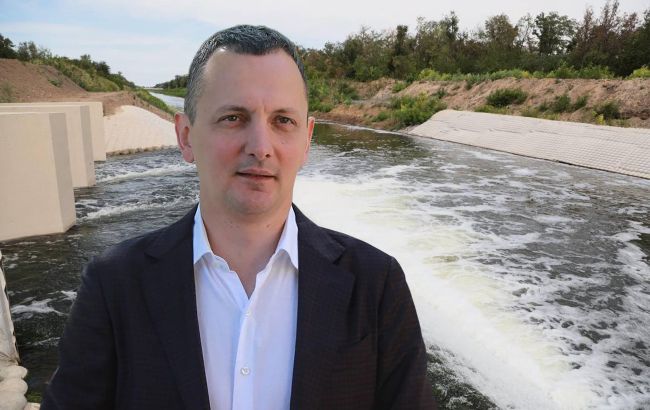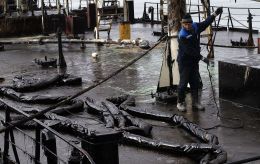Water scandal in Zelenskyy's hometown: Ukraine overpaid UAH 3 bln for pipeline
 Ukraine President's hometown overpaid UAH 3 bln for a pipeline project (photo: RBC-Ukraine)
Ukraine President's hometown overpaid UAH 3 bln for a pipeline project (photo: RBC-Ukraine)
One of the largest contractors involved in state-funded infrastructure projects — the Odesa-based company Avtomagistral-Pivden — allegedly inflated the cost estimate for the construction of the Inhulets–Southern Reservoir water pipeline by more than UAH 3 billion.
Moreover, the company is involved in a criminal investigation into money laundering through the project via conversion centers and fictitious agricultural companies that reportedly exported products to Romania—a scheme that helped legalize at least UAH 187 million.
On June 6, 2023, Russian forces blew up the dam of the Kakhovka Hydroelectric Power Plant. Its destruction led to a critical drop in water levels in the Kakhovka Reservoir, causing severe damage to the water supply infrastructure. As a result of this catastrophe, 1.5 million residents of Dnipropetrovsk, Zaporizhzhia, Mykolaiv, and Kherson regions were left without access to drinking water.
In the following weeks, the Ukrainian government approved the urgent construction of a network of new pipelines to restore water supply to these regions. One of the key projects was a new branch from the Inhulets River to the Southern Reservoir, intended to provide water to residents of Kryvyi Rih and nearby areas.
For just 26 kilometers of pipeline, the Infrastructure Recovery and Development Service in the Dnipropetrovsk region paid around UAH 7.7 billion — without holding a competitive tender. The project was executed by Avtomagistral-Pivden, owned by Odesa businessman Oleksandr Boiko. The company is linked to Yurii Holyk — the former public coordinator of the "Great Construction" program and ex-adviser to the head of the Dnipropetrovsk Regional Administration — who is currently under investigation for disclosing materials from a National Anti-Corruption Bureau of Ukraine (NABU) pretrial probe.
Over UAH 258 million for an unnecessary pumping station
As the contractor, Avtomagistral-Pivden was responsible for both the design and construction of the pipeline. The project was so oversized that it included not only excess piping but also an entirely unnecessary pumping station. According to the plan, a new trunk pipeline was to be laid from the Inhulets River to the Southern Reservoir, including three pumping stations. However, based on hydraulic pressure, terrain, and logic, only two were necessary.
Technical experts from a state research institute concluded that Pumping Stations 1 and 2 (PS-1 and PS-2) were sufficient to meet the required lift capacity at a calculated throughput of 4,200 m³/h.
"The capacity of the pumping units is sufficient to supply the designed flow rate without the construction of PS-3", reads the official conclusion from the institute, which was obtained by the editorial team.
Despite this, the project included the construction of PS-3 along with a suite of auxiliary facilities: a transformer substation, civil defense shelter, control post, autonomous power supply, video surveillance with 26 cameras, SCADA system, IP telephony, air conditioning systems, designer flooring on multiple levels, landscaping with decorative lawns, interior finishing, showers, ceramic tiling, and Armstrong ceilings.
Some specific expenses included:
- Tiles, decorative moldings, double-glazed windows — UAH 3.1 million.
- Ceiling finishes — UAH 1.5 million.
- Ventilation and air conditioning — over UAH 5 million.
- Video surveillance — UAH 600,000.
- Fire suppression and lightning protection systems — over UAH 3 million.
- Facade cladding — UAH 5.1 million.
As a result, the total cost overrun for this part of the project was UAH 258,345,726.80.
UAH 1.8 billion for pipes: four instead of two
Another major factor behind the inflated budget in the president’s hometown was the decision to use four pipelines of different diameters and materials.
"Polyethylene and fiberglass pipes. We sourced them from eight different suppliers across Europe. To lay them, we’re digging trenches 13 meters wide and 2.5 meters deep. For the intake facility, we had to temporarily reroute the Inhulets River. We’re undertaking an enormous volume of earthworks—2.4 million m³—to deliver water to the city as quickly as possible", reads a statement on the Avtomagistral website.
Experts argue that the project was technically unjustified. Pipes with varying diameters and materials create additional strain and can destabilize the entire system. Four pipelines also require more branches, joints, flanges, fittings, welding, and oversight.
The documentation contains no hydraulic justification for this setup, nor any comparative economic analysis.
As a result of this technical decision, the project required twice as many trenches, more excavation and backfilling, and 2–2.5 times more fittings (JAFAR valves — over 150 units), as well as artificially increased volumes of materials and installation work. The estimated overpricing for pipes, fittings, and pump equipment alone was UAH 371,817,834.70.
The institute’s feasibility study considered an alternative: two Ø1300 mm pipes, use of an existing reclamation channel without reconstruction, and eliminating PS-3. This alternative was nearly twice as cheap, required 2.33 times less annual maintenance funding, and could have been completed six months faster.
After reviewing the project documents, adjustments, and scientific oversight, analysts found that none of the materials provided any justification or efficiency assessment for using four differently sized pipelines instead of two or three uniform ones — which is fundamental to hydraulic planning.
There were also no calculations comparing different pipeline diameters and configurations, despite such comparisons being required in the technical brief. The rationale for installing four lines made of various materials and diameters — which may destabilize the pipeline’s operation — was entirely absent.
Preliminary technical estimates, combined with contract-based cost analysis, indicate that the overpricing amounted to approximately UAH 1,817,702,988. An additional UAH 346,728,878.52 in overpricing came from the unjustified reconstruction of a reclamation channel.
How much does sand cost if transported 260 km? UAH 372 million more
According to state construction standards, local materials are considered economically viable to transport within an 80 km radius. Beyond that, it is deemed inefficient.
That’s why large-scale infrastructure projects often establish temporary production bases. Instead, Avtomagistral-Pivden trucked sand from 264 km away—exceeding the standard by 184 km. The estimated cost overrun: UAH 373,248,676.00.
Similarly, slag was transported from 80 km farther than necessary, adding UAH 94,305,423.44 to the project cost. Prices for key construction materials — including fiberglass (GRP) and polyethylene pipes, JAFAR fittings, and pumping equipment — were also inflated. The estimated overpricing here was UAH 371,817,834.70.
Due to the opaque formatting of court decisions, the criminal investigation into money laundering in the "Inhulets–Southern Reservoir" project involving Avtomagistral-Pivden went unnoticed by the media.
According to the Unified State Register of Court Decisions, the Main Investigative Department of Ukraine’s National Police is conducting a pretrial investigation under case No. 12024000000000774, dated April 19, 2024. The charges fall under Articles 28(3) and 364(2) of Ukraine’s Criminal Code (abuse of power or official position by a group of persons) regarding suspected laundering of public funds in the Kryvyi Rih water pipeline project.
While company names are redacted in the case files, the context makes it clear the reference is to Avtomagistral-Pivden.
For example, a line in the materials reads: LLC INFORMATION_2 signed a contract with INFORMATION_3 on July 19, 2023, for the construction of the Inhulets–Southern Reservoir pipeline segment to supply Kryvyi Rih following the destruction of INFORMATION_4. Total value: UAH 5.3 billion. This clearly points to a contract with the Odesa-based firm linked to Holyk.
The context also reveals that pipes were purchased at inflated prices from LLC Shlyakhovyk-97, which then sourced them from manufacturers—allegedly to artificially raise the selling price.
Investigators believe Avtomagistral-Pivden staff submitted false completion reports, inflated the cost of goods and services, and redirected the excess budget funds to affiliated entities under the guise of service fees and rent for property and equipment. Tax invoices for such transactions totaled UAH 2.6 billion.
According to the case file, company officials later used so-called conversion centers to legalize these public funds by purchasing agricultural products from shell companies belonging to a transit group. Through export operations to affiliated entities, they laundered UAH 187 million worth of goods and underreported VAT by UAH 20.5 million.
UAH 3 billion in technical misunderstandings and an audit no one has seen
According to expert analysis obtained by the editorial team, the state likely overpaid by at least UAH 3 billion for the pipeline. The cause wasn’t just inflated prices — a classic corruption scheme — but also an economically and technically inflated project design. Chief among the excesses were the overhyped four pipeline lines. Altogether, in a project that cost UAH 7.7 billion, more than 39%—over UAH 3 billion—appears to have been unjustifiably overpaid.
LLC Avtomagistral-Pivden is one of Ukraine’s key players in public infrastructure procurement. It is closely associated with Yurii Holyk, coordinator of the "Great Construction" initiative and former adviser to the head of Ukravtodor.
Journalists report that Holyk promoted this contractor as "technically reliable" for roadworks, and since 2023, for critical infrastructure too. He frequently praised Avtomagistral-Pivden and pushed the narrative that PS-3 was "unavoidable" during closed-door meetings with Infrastructure Ministry officials.
The Infrastructure Recovery and Development Service commissioned the project in the Dnipropetrovsk region. The general designer was LLC NVO Transinzhyniryng. All project decisions were approved and passed state expert review, despite existing technical conclusions that explicitly opposed the construction of PS-3 and the additional pipelines.
Government publications claimed that the cost estimate had been reviewed by independent USAID experts, supposedly confirming the market-level pricing of materials used in the project.
However, the USAID Economic Resilience Activity project's website contains no actual audit report — only a statement that LLC SDM Engineering Ukraine conducted a "comprehensive feasibility assessment of the project documentation."
The same USAID audit is referenced in the Accounting Chamber’s report on transparency in infrastructure spending related to the Kakhovka disaster.
That same report, however, noted violations specifically involving the pipeline: "LLC Avtomagistral-Pivden purchased polyethylene pipes with a diameter of 1000 mm at inflated prices, resulting in an overpayment of UAH 112.76 million".
Against the backdrop of war, destruction, the lack of a development budget, and urgent military needs, someone found it convenient to "support infrastructure".
What will happen next? Most likely—nothing. Because everything was done by procedure. There are documents. There are expert reviews. There are signatures.

